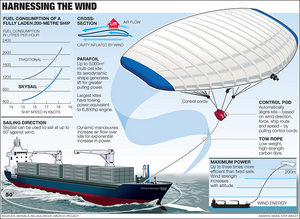
|
| ©Graphic News, Stef Bayley |
| Harnessing the wind |
Berlin -- A cargo ship pulled by a giant, parachute-shaped kite will leave Germany on Tuesday on a voyage that could herald a new "green" age of commercial sailing on the high seas.
The owners of the MS Beluga, a 462ft cargo vessel, will try to prove that modern steel ships can harness wind power and reduce their reliance on diesel engines.
During the journey from Bremen to Venezuela, the crew will deploy a SkySail, a 160 square metre kite which will fly more than 600ft above the vessel, where winds are stronger and more consistent than at sea level.
Its inventor, Stephan Wrage, a 34-year-old German engineer, claims the kite will significantly reduce carbon emissions, cutting diesel consumption by up to 20 per cent and saving £800 a day in fuel costs. He believes an even bigger kite, up to 5,000 square metres, could result in fuel savings of up to 35 per cent.
He got the idea while flying a kite as a child, and has now developed the concept into a hybrid of the sailing ships of old and motorised modern craft.
The MS Beluga's journey comes more than a century after the world's commercial sailing fleet was replaced by coal-burning steamships. Mr Wrage hopes for a similar revolution, and believes the kites could be suitable for up to 60 per cent of the world's 90,000 commercial ships: "Only the tough conditions imposed on a ship during a long voyage of this kind can show whether the SkySail is effective and whether the materials used in the kite can stand up to the stresses and strains," he said.
The kite works on a similar principle to rigs used by kite-surfers, who skim the water at up to 55mph, but bears little resemblance to canvas sails on conventional sailing ships.
Instead of support from a mast, boom and rope, the SkySail is tied to the bow by a single line that also contains a cable linking it to a computer, which controls it. It acts like a child's kite, carving figure-of-eight patterns in the air, reaching speeds four times higher than the prevailing wind, which dramatically increases its pulling power.



Reader Comments
to our Newsletter